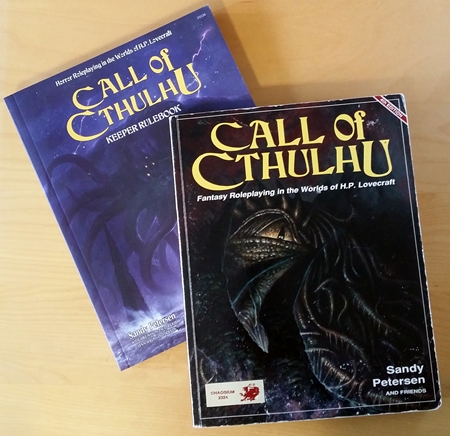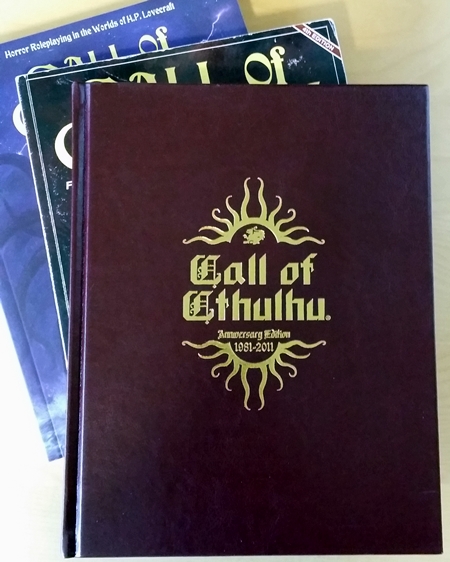Lately, when I read a new game (or assess one before buying it), I find myself asking this question: “How much of this do I need to run the game?”
I’ve still got Call of Cthulhu 7th Edition on the brain, and it’s really fucking huge — particularly compared to earlier editions. But is it usefully huge, or annoyingly huge?

I prefer short rulebooks to longer ones. The shorter the better. But not all lengthy rulebooks are created equal. For example, I can condense the DCC RPG — nearly 500 pages — into just 18 pages of rules I need to actually run the game.[1]
16 pages of chase rules
A post Kelvin Green made yesterday, The Stars Are Right(ish), gave me pause: He mentions that there are 16 pages of rules for car and foot chases in 7th edition. Sixteen pages!
A portion of those 16 pages are devoted to providing examples, something 7th edition is splendid about. There’s an example for everything. If a mechanic involves multiple steps, there’s an example for each step, and then an overall example pulling things together. Sometimes that feels overdone, but it’s hard to judge without playing the game.
Half a page is given over to examples of hazards in foot and car chases, things like “Cyclists in the road,” in list format. That’s a waste of space for me; a paragraph with an example or two would have done the job. But a first-time GM might enjoy it, and some folks might find the list format useful as opposed to wasteful.
But the simple fact that resolving a chase might make use of 16 pages of rules is a huge turn-off for me.
Bug or feature?
In that same vein, opinions will differ on whether a combat flowchart is a bug or a feature.

I almost closed the book and put it back on the shelf when I saw that. Seriously, a fucking flowchart!?
Maybe it’s a newbie/veteran thing again, though. Like, combat’s not all that complicated, but some people learn visually so let’s have a flowchart? Maybe! I hope so. Bad first impressions don’t always stick, as I saw over the course of two tremulus campaigns.
At this point, I’m still giving 7e the benefit of the doubt, but it’s starting to feel like I’m convincing myself to do that.
Apples to apples
I wanted to see if I was just getting off on the wrong foot with 7e, so I ran a quick comparison: core rules in another edition vs. core rules in this one.
When I run CoC, I reach for 4th edition. 7th edition is split into two rulebooks, but the Keeper Rulebook contains the core rules. As it notes on the back cover, though, you do also need a copy of the Investigator Handbook, which isn’t just a retreading of the same stuff minus the monsters and spells.[2]
Kelvin chalks up 130 pages of “actual game mechanics.” If I were printing out pages from the PDF for a condensed edition in the vein of DCC, though, I’d do pp.82-99 (core mechanics) and pp.102-129 (combat). I don’t need chase rules unless we’re having one. I don’t need sanity unless it comes up. Ditto magic, etc.
What I do need comes to 46 pages. How does that stack up to 4th Edition?
In 4th, I wouldn’t print a damned thing, because in 4e those same rules — core mechanics and combat — fit into 8 pages, and that’s being generous. It’s really 7 pages, plus a paragraph on the 8th page. There’s a stray page in the Sanity section I’d like, too, so let’s call it 9 pages.
How about 4e vs. 6e?
Hang on a minute, though. 4th and 7th have two full editions in between, plus several “.X” editions. Maybe the Girthening of Cthulhu happened in 5th or 6th edition, and I’ve just forgotten about it?
I’d love to compare every edition, really, but all but a couple of my copies of the core rules are in storage. I do have a copy of 6th edition I can get to, though.

6e is 320 pages, compared to 4e’s 192, so there’s been an increase in page count. But I’ve never cracked open any 1st-6th edition CoC rulebook and thought, “Boy, they’ve added a bunch of rules!”
Usually, they’ve added stuff: a full Lovecraft tale, more monsters, resources that used to be part of the Companions, etc. This is a game famous for having many editions with no substantial mechanical changes in 30 years, after all.
The core rules in 6e take up 11 pages. 12 if I throw in a bonus page from the Sanity section (like I did with 4e). Blergh.
Comparing 7e to both 4e and 6e, the mechanical complexity hasn’t changed dramatically. But it has changed. There’s more to do, more special cases are spelled out, there are more examples, and in the end, there are more numbers on the character sheet.
Different, I was interested in; more, not so much.
Hmmmm
I won’t know if a sixfold increase in pages devoted to core rules (7e vs. 4e), or even a fourfold increase (7e vs. 6e), is actually a problem in play until I play the game. But it does sap my interest in playing at all, as does the overall size of this two-book edition.
I love CoC, and I like what I’ve seen of the new rules — bonus dice are particularly clever, and pushing skill rolls looks like a great addition. I’m not sure I’ll keep poking at 7th edition, though.
[1] DCC is a special case for other reasons, too. Each spell takes up a full page, most of which is a chart; that’s over a hundred pages right there, and you don’t need all or even most of it at any given time. Art is another reason: squished together, there’s about a hundred pages of artwork in the book. I still find it overlarge at the table, hence the condensed version.
[2] I’m largely taking that as an article of faith, although a skim of the Investigator Handbook suggests that there’s nothing in there one absolutely needs to run the game.

Different, I was interested in; more, not so much.
Me too. This is a game that — for me — did not need more rules. I’m sure a big section of the audience will disagree, and that’s fine. This edition will be for them.
I need to dig a little deeper on the actual new rules. The bonus dice thing is great, and would be easy to port into past editions.
Pingback: Daily Snapshot – May 16, 2016 – OSR Today
They could have done themselves a big favor by taking a look at Tynes & Cooke’s take on handling Mythos artifacts (like books). D20 makes reading books an in-game process again, and does it better than any version of BRP Call of Cthulhu I’ve read.
By 6th edition the Tomes were so unavailable that it “made sense” to have a quick and dirty penalty mechanism – only NPCs would ever suffer them.
This seemingly (to this first edition early adopter) because the editors believed that the model for reading a Mythos Tome should be based on the process as described in The Dunwich Horror.
However, that process was actually Magical Research done using multiple damaged copies, *not* a straight scholarly reading of the text.
That and the ridiculous contention that a magical laboratory book like the Necronomicon would have no table of contents or index. So the Mad Arab never needed to look up anything in his notes? The why write them in the first place? And what about the “lesser” wizard who translated the thing into Greek?
I could go (and have gone) on with more of this blither, but for me the salient point is that Call of Cthulhu here in America as much as in the UK is a game in which would-be GMs seem to spend half their time bemoaning that players “don’t get” the game from a purist stance and the other half bemoaning the lack of players for it.
The irony is palpable.
While my D20 group is smaller than it was when I started it, the players are keen and engaged and immersed five years down the road. They also occasionally stray from the path and get sucked in with fun results. The gobsmacked look on the face of a player who has just realized that what his character did “last night” makes him a cultist is pure GM gold.
But that experience was all-but denied in 6th edition due to stupid and counter-productive rules. *Every* GM I spoke to was working around them which prompted me to ask the value of rules you couldn’t use.
I’m currently going through my 7th ed copy to compare and contrast. I too like the bonus/penalty die. Also Luck spend. And Pushing It (though I think it stands a chance of derailing the game if you have an ALPHA player determined to MAX his benefit while MINning his blowback if he screws up the roll a second time; I can envisage lengthy “negotiations” and face-aching).
I’m currently playing from 5.softcover (who thought document release numbering was a good marketing idea? Feed ’em to the shoggoth!) with some gold book combat stuff poke into it to make the confusion about dodge and parry go away.
And on that, its nice that parry is now officially an action of opportunity rather than an archaic throwback to a fencing scenario from a fantasy game. The daft “pick your parry target and use it or lose it” mechanism was a non-starter from the get-go and a cauldron in which to brew much bad feeling during moments of high dramatic tension.
Good reading, as always Martyn.
Thanks!
Count me as a fellow fan of the d20 edition, although in my case it’s because I find its explanation of the Lovecraftian universe and why it’s fun to be the best one out there.
But seriously saddened to hear that I’ll have to fork out another 25 bux for a Player Guide for rules completion if I want to migrate to 7th ed.
This could be the proverbial straw.
While I agree with your tendency to condense rules into smallest possible amount of pages needed to run a game… I don’t agree with your critique of flow charts. Flow charts are exactly what you advocate for – condensed rules on one page in visual form. You can print combat and damage flow charts and you are good to go in 2 pages. Everything else in CoC is d100 roll anyway. There’s nothing wrong in “rich” edition. If you are advanced GM, then you don’t care anyway, if you are new player, rich book with examples immerses you more in the game.
Yeah, that’s why I flagged it as something that will appeal to some folks. I like flowcharts when they’re needed, and if they’re needed here then having one is better than not — I just wish 7e combat hadn’t reached the point where it needed one.
I much prefer 7th edition. The rule changes are good changes. All of combat and damage can fit on a single sheet of paper (just print the flow charts back to front).
The miserable rules for the contested roll table is gone. The GM does not have to decide if it is a 10% penalty or a 15% penalty; just add a penalty die. I like that my players have the option to push rolls.
Warm regards, Rick.
I’m glad you’re digging 7th, Rick!
I may yet wind up giving it a try (and I’d certainly try it if someone offered to run it). These days tremulus scratches 100% of my Call of Cthulhu itch.